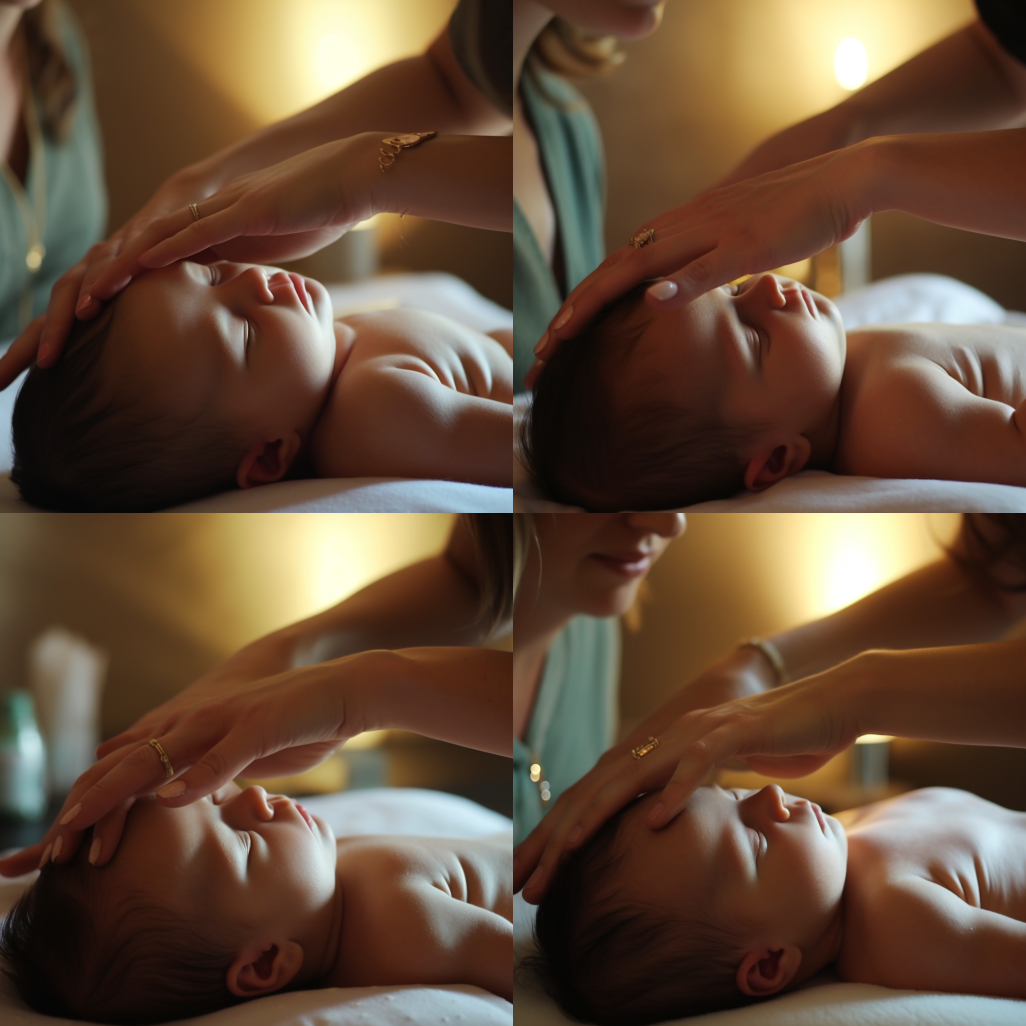The Ultimate Guide to Baby Massage for Better Sleep
Getting your baby to sleep through the night is a top priority as a parent. While there are many methods for helping your baby fall asleep, one natural and effective option is baby massage. In this blog post, we will discuss the benefits of baby massage for sleep and how to do it properly.
Benefits of Baby Massage for Sleep
- Promotes relaxation and reduces stress
- It helps regulate sleep patterns
- Enhances parent-child bonding
- Reduces colic and other digestive issues
- Improves circulation and overall well-being
Tips for Baby Massage for Sleep
- Choose a quiet and comfortable environment for the massage.
- Use natural oils like coconut or olive oil to avoid skin irritation.
- Begin gently on the baby’s face and forehead, moving to their chest and belly.
- Use long strokes on the arms and legs and gentle circular motions on the palms and soles of the feet.
- Follow your baby’s cues and adjust your technique to suit their needs.
- Massage your baby for 10-15 minutes until they appear relaxed and ready for sleep.
Precautions for Baby Massage for Sleep
- Avoid massaging if the baby is ill or has a fever.
- Always be gentle and avoid putting too much pressure on the baby’s sensitive areas.
- Stop the massage if your baby appears uncomfortable or in pain.
Where should I massage my baby to sleep?
- Legs and feet: Gently massage your baby’s legs, starting from the thigh and working down to the ankle. Use gentle, circular motions around the ankle and foot, and remember to massage the sole.
- Arms and hands: Begin at the shoulder and work down to the wrist. Gently massage the baby’s palms, fingers, and wrists in circular motions.
- Chest: Place your hands on your baby’s chest and gently massage in outward, circular motions.
- Back: With your baby lying on their tummy, gently massage their back using long, sweeping strokes from the neck down to the buttocks.
- Head and face: Use your fingertips to gently massage your baby’s scalp in a circular motion, avoiding the soft spot on the top of their head (fontanelle). You can gently rub the baby’s face, using circular motions around the forehead, cheeks, and chin.
When should I stop massage my baby?
- Watch for cues: Your baby will give you alerts when they no longer enjoy the massage or feel uncomfortable. These cues include fussing, crying, or squirming away from your touch. If your baby shows any of these signs, stopping the massage is a good idea.
- Pay attention to the length of the massage: Generally, a baby massage session should last no longer than 15-20 minutes. If you go beyond this time, your baby may become restless and uncomfortable.
- Avoid massaging your baby if they are ill: If your baby is sick or has a fever, it’s best to avoid massaging them until they feel better. Rubbing an ill baby may worsen their condition or cause discomfort.
- Be aware of any medical conditions: If your baby has any medical conditions or injuries, it’s important to avoid massaging those areas or consult your pediatrician for proper guidance.
Should I massage my baby before or after bath?
Massaging your baby can be done before or after a bath, depending on your baby’s preferences and your routine. Both options have their advantages:
- Before bath: Massaging your baby before a bath can help relax and calm them down. This relaxation can make the baby’s bathing experience more enjoyable and soothing. Additionally, if you’re using any oils for the massage, the bath will help wash them off, reducing the chance of any skin irritation.
- After bath: Massaging your baby after a bath, when they are already clean and warm, can help lock in moisture and further relax your baby before bedtime. Ensure the room is warm and cozy so your baby doesn’t feel cold after the bath. If you massage your baby after the bath, you can moisturize their skin with a gentle baby lotion or oil.
Why do babies cry after massage?
Babies may cry after a massage for several reasons. Still, it’s important to note that crying is a normal part of a baby’s communication and doesn’t necessarily mean something is wrong. Here are a few reasons why a baby may cry after a massage:
- Overstimulation: Babies have sensitive skin, and a massage can be a lot of stimulation for them. If the massage is too long or too intense, it may cause the baby to become overstimulated and cry.
- Discomfort: Babies may also cry if they are uncomfortable during the massage. This could be due to a position that is uncomfortable for them or pressure that is too strong.
- Hunger or fatigue: If a baby is hungry or tired, they may cry during or after a massage to communicate their needs.
- Release of tension: Sometimes, a massage can release tension in a baby’s body, which can cause them to cry to release emotions.
- New experience: If the baby is new to massages, they may not be used to the sensation and may cry.
How long after feeding should I massage baby?
It’s generally recommended to wait at least 45 minutes to an hour after feeding before giving your baby a massage. Massaging a baby’s tummy too soon after a feeding can cause discomfort or even vomiting.
After waiting an appropriate amount of time, you can begin the massage by ensuring your baby is in a comfortable and safe position. You can start with gentle strokes on your baby’s back, arms, and legs and gradually work to the tummy area.
You may also be interested:
- How To Massage Your Baby For Constipation
- Sweet Dreams: The Best Sleep-Friendly Toys for Babies and Toddlers
How much gap between feeding and massage?
As a general guideline, waiting at least 45 minutes to an hour after feeding before massaging your baby is recommended. This is because massaging a baby’s tummy too soon after a feeding can cause discomfort or even vomiting.
However, it’s important to note that every baby is different, and what works for one baby may not work for another. Some babies may be able to tolerate a massage sooner after feeding, while others may need more time to digest.
How do you massage a gassy baby?
- Find a comfortable and quiet area: Choose a quiet and peaceful place where your baby can relax and feel comfortable. Make sure the room is warm and draft-free.
- Place your baby on their back: Lay it on a soft, flat surface, such as a changing table or a blanket on the floor.
- Start with gentle strokes: Begin by gently stroking your baby’s belly with your fingertips in a clockwise direction. Use a light touch and keep your strokes soft and slow.
- Do the “I Love You” stroke: Use the “I Love You” stroke to help release trapped gas. To do this stroke, start by placing your hand on your baby’s belly, with your fingers pointing towards their head. Make the letter “I” by stroking up the left side of your baby’s belly, then make the letter “L” by stroking across the belly, and finally make the letter “U” by stroking down the right side of the belly.
- Do the bicycle legs exercise: Gently move your baby’s legs in a cycling motion to help release gas. Hold your baby’s legs together and slowly move them in a circular motion like your baby is riding a bicycle.
- Burp your baby: After the massage, try to burp your baby to help release any remaining gas.









5 Comments